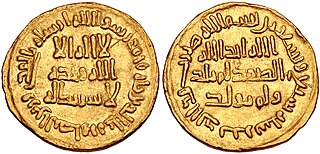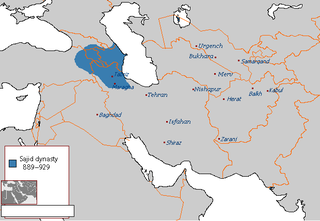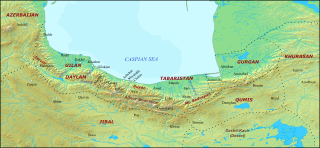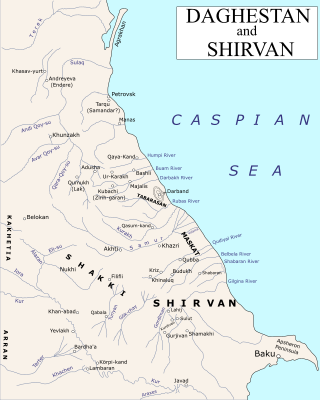Related Research Articles

Sulayman ibn Abd al-Malik was the seventh Umayyad caliph, ruling from 715 until his death. He began his career as governor of Palestine, while his father Abd al-Malik and brother al-Walid I reigned as caliphs. There, the theologian Raja ibn Haywa al-Kindi mentored him, and he forged close ties with Yazid ibn al-Muhallab, a major opponent of al-Hajjaj ibn Yusuf, al-Walid's powerful viceroy of Iraq and the eastern Caliphate. Sulayman resented al-Hajjaj's influence over his brother. As governor, Sulayman founded the city of Ramla and built the White Mosque in it. The new city superseded Lydda as the district capital of Palestine. Lydda was at least partly destroyed and its inhabitants may have been forcibly relocated to Ramla, which developed into an economic hub, became home to many Muslim scholars, and remained the commercial and administrative center of Palestine until the 11th century.
Yazid ibn al-Muhallab al-Azdi was a commander and statesman for the Umayyad Caliphate in Iraq and Khurasan in the early 8th century. In 720, he led the last of a series of wide scale Iraqi rebellions against the Umayyads.

The Kakuyids were a Shia Muslim dynasty of Daylamite origin that held power in western Persia, Jibal and Kurdistan. They later became atabegs (governors) of Yazd, Isfahan and Abarkuh from c. 1051 to 1141. They were related to the Buyids.

The Sajid dynasty, was an Iranian Muslim dynasty that ruled from 889/890 until 929. The Sajids ruled Azerbaijan and parts of Armenia first from Maragha and Barda and then from Ardabil. The Sajids originated from the Central Asian province of Ushrusana and were of Iranian (Sogdian) descent. Muhammad ibn Abi'l-Saj Diwdad the son of Diwdad, the first Sajid ruler of Azerbaijan, was appointed as its ruler in 889 or 890. Muhammad's father Abu'l-Saj Devdad had fought under the Ushrusanan prince Afshin Khaydar during the latter's final campaign against the rebel Babak Khorramdin in Azerbaijan, and later served the caliphs. Toward the end of the 9th century, as the central authority of the Abbasid Caliphate weakened, Muhammad was able to form a virtually independent state. Much of the Sajids' energies were spent in attempting to take control of neighboring Armenia. The dynasty ended with the death of Abu'l-Musafir al-Fath in 929.
Muhammad bin Musafir was the Sallarid ruler of Tarum in modern northwest Iran and Iranian Azerbaijan (949). He was the son of Musafir, and his original name seems to have been Sallar or Salar ; 'Sallar' would later become a title used by his successors.

Daysam ibn Ibrahim al-Kurdi was a Kurdish commander who occasionally ruled Adharbayjan between 938 and 955 during the power struggle that ensured after the fall of the Sajid dynasty.

Tabaristan or Tabarestan, was the name applied to a mountainous region located on the Caspian coast of northern Iran. It corresponded to the present-day province of Mazandaran, which became the predominant name of the area from the 11th-century onwards.

The Justanids or Jostanids were an Iranian Zaydi Shia dynasty that ruled a part of Daylam from 791 to the late 11th century.
The Yazidids were an Arab family what came to rule over the region of Shirvan in the mid 9th century. From Haytham ibn Khalid's assumption of the ancient Iranian title of Shirvanshah in 861, they practically broke free of Abbasid control and ruled Shirvan more or less independently until the 14th century.

The term Iranian Intermezzo, or Persian Renaissance, represents a period in history which saw the rise of various native Iranian dynasties in the Iranian Plateau after the 7th-century Muslim conquest of Persia and the fall of the Sasanian Empire. The term is noteworthy since it was an interlude between the decline of Abbāsid rule and power by Arabs and the "Sunni Revival" with the 11th-century emergence of the Seljuq Turks. The Iranian revival consisted of Iranian support based on Iranian territory and most significantly a revived Iranian national spirit and culture in an Islamic form, although there were some Iranian Zoroastrian movements rejecting Islam altogether as a religion. It also focused on reviving the Persian language, the most significant Persian-language literature from this period being Shahnameh by Ferdowsi. The Iranian dynasties and entities which comprise the Iranian Intermezzo are the Tahirids, Saffarids, Sajids, Samanids, Ziyarids, Buyids, Sallarids, Rawadids, Marwanids, Shaddadids, Kakuyids, Annazids and Hasanwayhids.
Lashkar Haytham ibn Khalid was the first Shirvanshah, or independent ruler of Shirvan, renouncing the suzerainty of the Abbasid Caliphate in 861 and beginning the Mazyadid dynasty.

Muhammad III was the third Layzanshah and the seventh Shirvanshah. He was the son of Abu Tahir Yazid.
Muhammad IV was the Shirvanshah from 981 to 991. He was the son and successor of Ahmad.
Manuchihr, Minuchihr or Manuchehr I was the eleventh Shah of Shirvan. He is considered to be first fully Persianized ruler of the dynasty. Starting from his rule, the Shirvanshahs favoured names from the pre-Islamic Iranian past and claimed descent from characters such as the Sasanian monarch Bahram V Gur.
Qubad was the thirteenth Shah of Shirvan, a younger brother of his predecessor Ali II.
Abu Shuja Salar was the fifteenth Shah of Shirvan. He was the uncle and successor of Bukhtnassar.

Farrukhan the Great was the independent ruler (ispahbadh) of Tabaristan in the early 8th century, until his death in 728. He defended his realm from the Umayyad Caliphate, who, under Yazid ibn al-Muhallab were defeated by Farrukhan, who laid ambush to his army. He took the titles Ispadbadh, Padashwargarshah and Gilgilan and defeated a Daylamite revolt to his west. The city of Sari, Iran and the Shahr E-Espohdban were founded under him, and he moved his capital there. He also spent much of his reign fighting the Dabuyid nobility, in which he was successful, and Farrukhan died in 728 with his son Dadhburzmihr succeeding him.

The Qarinvand dynasty, or simply the Karenids, was an Iranian dynasty that ruled in parts of Tabaristan (Mazandaran) in what is now northern Iran from the 550s until the 11th-century. They considered themselves as the inheritors of the Dabuyid dynasty, and were known by their titles of Gilgilan and Ispahbadh. They were descended from Sukhra, a Parthian nobleman from the House of Karen, who was the de facto ruler of the Sasanian Empire from 484 to 493. The Qarinvand dynasty is also considered to be the one of the last Zoroastrian dynasties before the rise of the Islamic Iranian dynasties
Muhammad ibn Husayn al-Rawadi was the founder of the Rawadid dynasty, ruling parts of Armenia and Azarbaijan in the mid 10th-century. He was succeeded by his son Abu'l-Hayja Husayn I between 953–956.

The Hashimids were an Arab family who ruled over Bab al-Abwab (Darband) in Daghestan from 869 to 1075.
References
- ↑ Madelung 1975, p. 249.